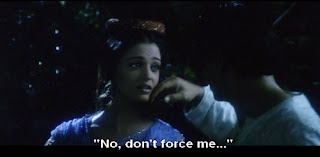Black Narcissus: A parable of colonialism, or who's the narcissist?
 Michael Powell and Emeric Pressburger's Black Narcissus (1947) is a classic of Technicolor cinematography. It's also a classic of colonialist ideology.
Michael Powell and Emeric Pressburger's Black Narcissus (1947) is a classic of Technicolor cinematography. It's also a classic of colonialist ideology.
A small group of Anglican nuns led by Sister Clodagh (Deborah Kerr) is sent to establish a convent in a remote Himalayan village. They are given a mountaintop palace once occupied by concubines, and plan to create a school, infirmary, chapel, and garden on its grounds. But the isolated setting, the constant wind, the obstinacy of the "natives," the erotic paintings on the walls, and the propensity of the local English agent Mr. Dean (David Farrar) to wander about shirtless are soon whipping up hysteria among the nuns.
The story, based on a Rumer Godden novel, is ludicrous, especially when Sister Ruth (Kathleen Byron) snaps, dons a siren-red dress, lipstick and high-heeled shoes, throws herself at Mr. Dean and—spoiler alert!—tries to push Sister Clodagh off the mountain. The convent is doomed by the combined force of the villagers' indifference and the eruption of the nuns' own repressed emotions.
What's harder to stomach than the film's pop Freudianism, though, is its depiction of the Indian villagers. "Black Narcissus" is the nuns' nickname for the Young General (Sabu), the son of the village headman, who dresses in colorful finery and attends the children's classes in English, French and typing (very useful skills in a remote Himalayan village). When the "natives" are not being shown as childlike, comically vain imitators of the English, they are shown as inscrutable, dangerously sexual, or ominously threatening.
So it should come as no surprise that the filmmakers couldn't even be bothered to get the details of the Indians' culture right. I'm no expert, but when on several occasions we hear the drums of the villagers, their rhythms sound more like Skull Island (from King Kong (1933)) than Himalayan Indian. The clothes look like a mix of regional Indian styles with a heavy overlay of film-studio fantasy. And as 17-year-old Kanchi, a young Jean Simmons—in obvious brownface—is asked to perform hilariously inept "Indian" dance moves.
It could be that there's a satirical tone that I'm just missing. The shots of Sister Ruth in her mad frenzy verge on camp:
But I don't think the filmmakers intend any satire. The music cues us when a scene is meant to be lighthearted (most of those involve May Hallatt, who plays the caretaker Angu Ayah without brownface and with a broad Cockney accent). The gorgeous cinematography, the somber tone and the lingering closeups of a conflicted Deborah Kerr give the rest of the film a sheen of high seriousness. Our perspective remains almost entirely on the mountaintop with the nuns, and it is they with whom we are invited to sympathize. I think we are meant to see the nuns as well-meaning but naïve, attempting to do good work in a place where the climate is unsuitable and the ignorant, superstitious people are stubbornly unreceptive.
But this is classic colonialist ideology, liberal version, as memorably described by Noam Chomsky (in "Objectivity and Liberal Scholarship," from American Power and the New Mandarins (Pantheon, 1967)) and Edward Said (in Orientalism (Vintage, 1979)). To make the suggestion the nuns are serving the British imperial project and that the Indians have their own subjectivity requires reading the film against the grain.
The film's elegiac final images, where the monsoon rains begin to fall as the nuns leave the village, take on a different meaning when you note the date of the movie's release. 1947, of course, was the year that the entire British imperial project in India was abruptly abandoned. That self-regarding sense of melancholy at the end of Black Narcissus ignores, as does the rest of the film, the experience of the Indians themselves. And so it functions as a sort of parable about the loss of the Raj—only in real life the self-concern of the British turned out to have deadly consequences for their former subjects, a legacy of displacement and violent conflict that continues today. It prompts me to ask: Who are the narcissists here?





















